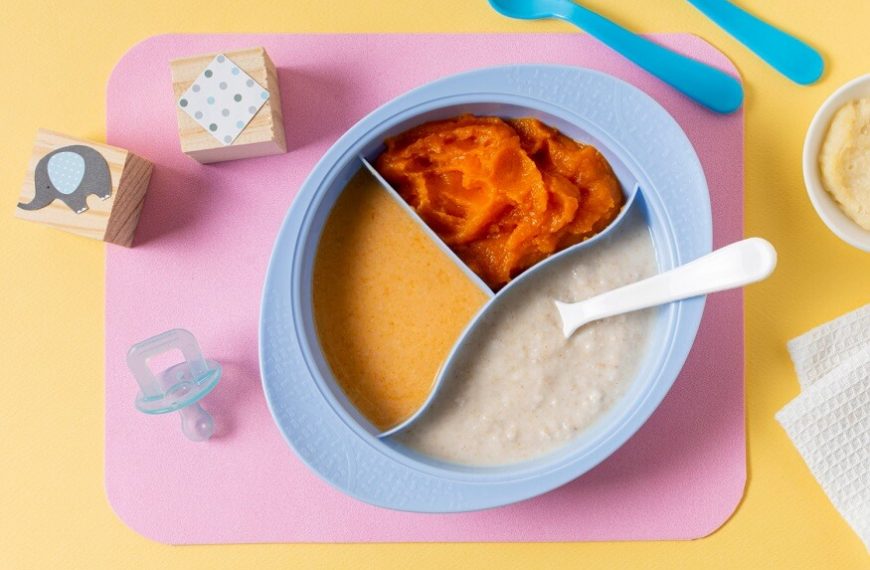Introducing Solid Foods to Your Baby
Imagine the wide-eyed wonder of your little one as they experience the novel texture of mashed banana for the first time, or their comical expression upon tasting the tangy sweetness of a pureed apple. The transition from exclusive breastfeeding or formula-feeding to solid foods is a sensory adventure for your baby and a significant milestone, tinged with a blend of excitement, anticipation, and perhaps a smidgen of anxiety for you. This critical phase in your baby’s growth and development requires careful planning and deep understanding. Let’s delve into effective strategies for introducing solid foods to your baby, underscoring the importance of infant foods and adhering to the infant solid food guidelines.
Getting Started: Understanding the Transition to Solid Foods
The transition to solid foods is a milestone in your baby’s nutritional journey. It’s not merely about switching from breastfeeding or formula-feeding to solids; it’s about preparing your child for a lifetime of eating habits. This process involves gradually introducing solid foods infants will accept and enjoy, while still ensuring that they receive all the essential nutrients needed for their growth and development. The introduction of solid foods should ideally begin when your baby is around six months old, according to the American Academy of Pediatrics.
Infant Solid Food Guidelines: A Guiding Light
The infant solid food guidelines are there to ensure a smooth transition for both the baby and the parents. They provide a roadmap for when and how to introduce solid foods to your baby. While each child is different, these guidelines offer a framework that helps parents make informed decisions and avoid potential pitfalls.
As per these guidelines, it’s important to introduce single-ingredient foods first. This approach allows parents to identify any potential allergies or intolerances. Also, don’t rush the process. Let your child set the pace. It can take several tries before they accept a new food. Remember, this is a learning process for your baby, so patience is key.
The Importance of Infant Foods in the Transition
Infant foods play a crucial role in this transition. They are specifically designed to meet the nutritional needs of infants and are easier to digest. Solid food for infants often comes in the form of purees or finely mashed foods, which make it easier for your baby to swallow and digest.
As your baby becomes more accustomed to these textures, you can gradually introduce chunkier foods. This gradual approach helps the baby develop the necessary chewing and swallowing skills while ensuring they are receiving the right nutrients.
Best First Foods for Your Baby
When it comes to your baby’s first foray into solid foods, consider starting with single-grain cereals like rice or oatmeal, pureed fruits and vegetables such as apples, bananas, and sweet potatoes, or pureed meat. These foods are nutritious, easy to digest, and less likely to cause allergic reactions. Gradually, as your baby gets used to these, you can introduce a wider variety of foods.
Tips for Introducing Solid Foods to Your Baby
Start Slowly: As mentioned earlier, the introduction of solid foods should be a gradual process. Start with small amounts of single-ingredient food and observe your baby’s reactions.
Follow Your Baby’s Cues: Your baby will give you cues to indicate their readiness for solid foods. These include showing interest in what you’re eating, opening their mouth when food comes their way, and being able to sit up with support. Follow these cues and don’t rush the process.
Introduce a Variety of Foods: Once your baby has adjusted to a few foods, introduce them to a variety. This will help them get used to different flavours and textures and can help ensure a balanced diet.
Make Mealtimes a Positive Experience: Make the introduction of solid foods a fun and positive experience. Encourage your baby to explore the food, even if it gets a bit messy.
Remember the Importance of Iron: Iron is crucial for your baby’s development. Ensure the solid foods infant consumes are rich in iron, such as pureed meat or iron-fortified cereals.
Stay Hydrated: As your baby starts eating solid foods, ensure they’re still getting enough liquids. Continue breastfeeding or formula feeding, and as your baby grows, introduce small amounts of water.
What to Avoid When Introducing Solid Foods
While introducing solid foods, steer clear of honey until your baby is at least a year old due to the risk of botulism. Similarly, avoid cow’s milk until your baby’s first birthday, as it doesn’t provide the necessary nutrients. Whole nuts and grapes pose choking hazards and should be avoided until your child is older and can chew foods thoroughly.
Common Issues When Introducing Solid Foods
You may face some common issues when introducing solid foods to your baby. These can range from food refusal, allergies, and choking, to constipation. It’s essential to introduce new foods one at a time and wait a few days before introducing another. This way, if your baby has a reaction, it’s easier to pinpoint the cause. If your baby refuses a certain food, don’t fret. It can take numerous exposures to a new food before a baby accepts it.
Imagine sitting at the dining table years from now, reminiscing about your child’s first encounter with solids – the curious pokes at the mashed avocado, the tentative tastes of sweet potato puree, the playful splattering of pureed peas. The journey of introducing solid foods to your baby, while seeming challenging at first, can become one of the most cherished chapters of parenthood. By following the infant solid food guidelines, acknowledging the vital role of infant foods, and introducing solid food for infants in a gradual, fun-filled way, you can ensure a smooth transition. It’s a unique journey, filled with messy fun, new discoveries, and invaluable bonding moments. Embrace this beautiful chaos and savour these special times with your baby – they are growing up faster than you think!
At EuroKids, we understand the importance of a nutritious diet for kids. We hope that you found the blog useful. In case you want to read more of our blogs on various parenting and child development topics, head to our blog section!














